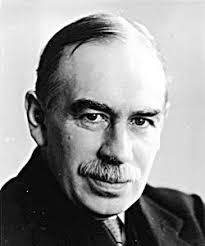
The work of noted economist John Maynard Keynes is used to justify a bigger government role in the economy. After the recent (or more accurately current) crisis it is understandable that many would return to this economist. Yet most who do not read economics know very little about him and his economic philosophy in his most noted work, “The General Theory of Employment, Interest, and Money.” It is not a surprise that his economic theory developed during the popularity of socialism.
Keynes considered savings a very bad policy for an economy. He considered the Calvinist doctrine of savings a distortion of common sense. Keynes advocated an interest rate of 0% to be achieved by the government controlling the money to be made available for capital investment. To Keynes the world was mired in poverty because the rich controlled the capital and always charged too much interest. The zero interest he advocated is a reversion to the early church’s ban on charging interest that characterized the Dark ages.
He advocated confiscatory taxes to take money from the rich because they would save it, and give to the poorer so they would spend it. Spending was his sole economic driver. Private capital could not be trusted to do good for society.
His present focused economic view was the engine for the socialist redistribution he and so many advocated. By driving interest to zero and making capital freely available there would be no unemployment.
The flaws in his thinking are so enormous that it stuns me how many believe it makes sense. For example, how do you explain the record high unemployment we now have with the record low interest rates now available? With zero interest how do we prioritize one investment opportunity from another?
The antithesis to Keynes is Ludwig von Mises who published “The Theory of Money and Credit” in 1912. In “The Man Who predicted the Depression” Mark Sitznagel noted,
“Government-imposed expansion of bank credit distorts our “time preferences,” or our desire for saving versus consumption. Government-imposed interest rates artificially below rates demanded by savers leads to increased borrowing and capital investment beyond what savers will provide. This causes temporarily higher employment, wages and consumption.
“Ordinarily, any random spikes in credit would be quickly absorbed by the system-the pricing errors corrected, the half-baked investments liquidated, like a supple tree yielding to the wind and then returning. But when the government holds rates artificially low in order to feed ever higher capital investment in otherwise unsound, unsustainable businesses, it creates the conditions for a crash. Everyone looks smart for a while, but eventually the whole monstrosity collapses under its own weight through a credit contraction or, worse, a banking collapse.”
“…Ludwig was very nearly alone in warning of the collapse to come from this credit expansion. In mid-1929, he stubbornly turned down a lucrative job offer from the Viennese bank Kreditanstalt, much to the annoyance of his fiancée, proclaiming “A great crash is coming, and I don’t want my name in any way connected with it.”
“overleveraged banks (including Kreditanstalt) collapsed, businesses collapsed, employment collapsed. Following Mises’s logic, was this a failure of capitalism, or a failure of hubris?”
Keynes predicted in 1927 “We will not have any more crashes in our time. I find the markets very interesting, and the prices low. So where should a crisis come from?”
Unlike Keynes von Mises’s theories stand up to observation and common sense, yet our government economists prefer the ideas of Keynes.

Recent Comments